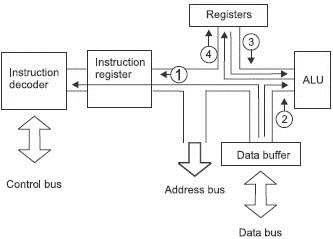Книга: Introduction to Microprocessors and Microcontrollers
Machine code
Machine code
The binary code that is understood by the microprocessor is called machine code and consists of streams of binary bits. They are fed from the RAM or ROM memory chips in blocks of 8, 16, 32 or 64 depending on the microprocessor in use. To us the binary stream is total gibberish.
Example
If we refer to the Z80180 block diagram in Figure 9.3 we can investigate the instruction necessary to add two numbers together. One of the numbers is already stored in the accumulator or register A. Let’s assume this is the number 25H.

Figure 9.3 The microprocessor adds two numbers
In comes the instruction: 11000110 00010101. It is in two parts, the first byte, 11000110, means add the following number to the number stored in the accumulator. This first byte which contains the instruction is called the operation code, usually abbreviated to ‘op code’. The second byte, 00010101, is the number 15H. This particular instruction has two bytes. Some instructions have only the one byte and others three or more bytes. The additional bytes contain the data to be used by the op code and is called the operand.
And here’s the action
1 The first byte goes into the instruction decoder where it is decoded into a sequence of internal operations.
2 It then copies the number 15H from the data buffer into ALU, the arithmetic and logic unit.
3 The number 25H from the accumulator is then copied into the ALU to join the 15H which is already there. The two numbers are added.
4 And the result is copied back to the accumulator.
What is the result?
It is 3AH. Be careful not to let your brain jump back to decimal mode and shout 40 at you.
At the end of a machine-code program, we must include an instruction to stop the program, otherwise we can get some unexpected or unwanted results. You may remember that, at least in the development stages, the program is often stored in RAM.
Now, RAM locations take up random values when they are switched off so when the program has completed the last instruction, it will start executing the random values as if they were a program. These instructions may, of course, do anything at all. They could even delete or change the program that we have just written. Overall, the effect is like an aircraft overshooting the end of a runway.
- Using the autoconf Utility to Configure Code
- 9. Programming – using machine code and assembly
- The problems with machine code
- Системные переменные ROWS_AFFECTED, GDSCODE, SQLCODE, TRANSACTIONJD, CONNECTIONJD
- Chapter 7. The state machine
- Appendix J. Example scripts code-base
- Example NAT machine in theory
- What is needed to build a NAT machine
- Placement of NAT machines
- The final stage of our NAT machine
- Test Driver Code
- Regulating Code to Regulate Better




